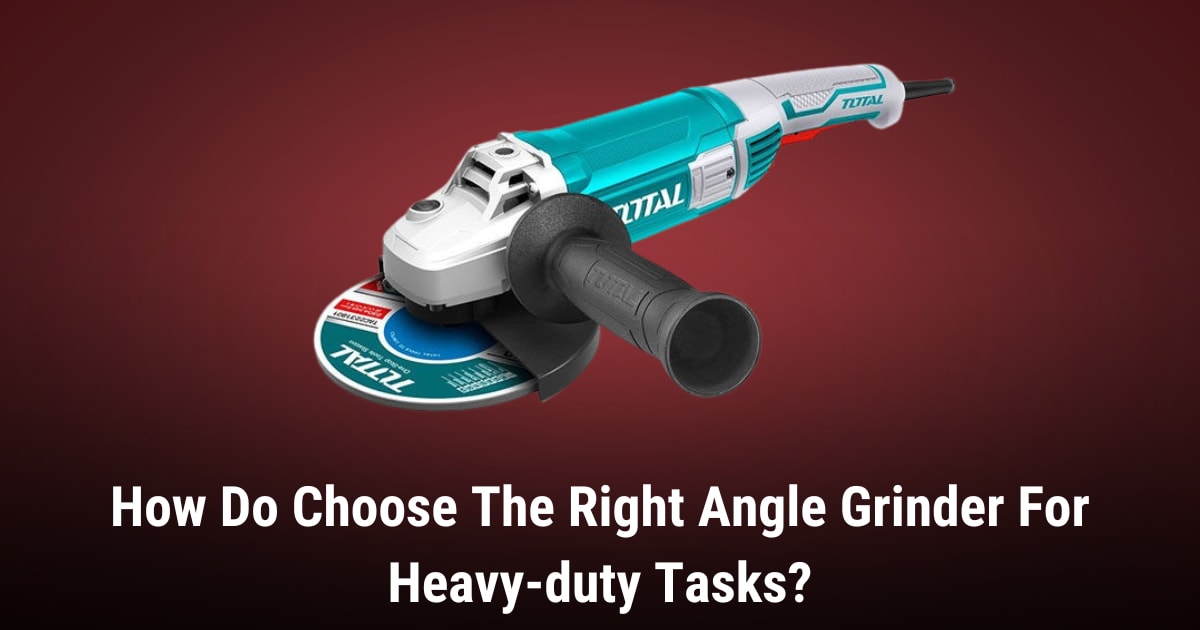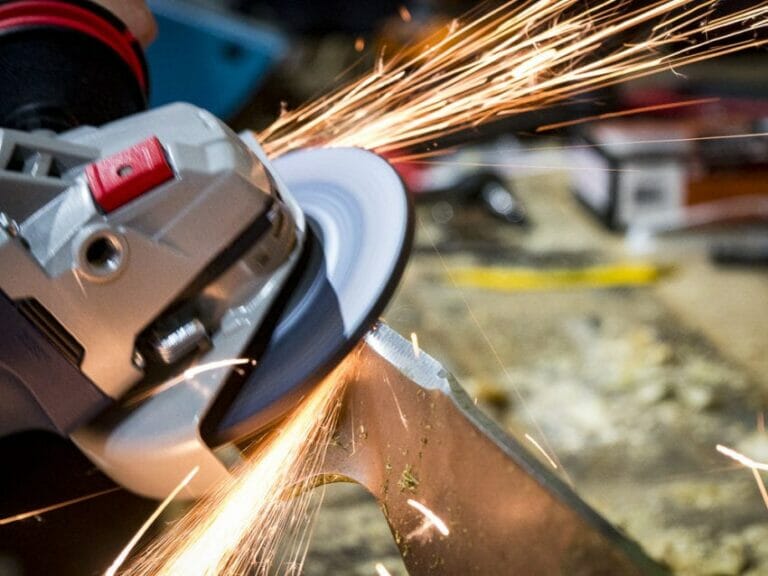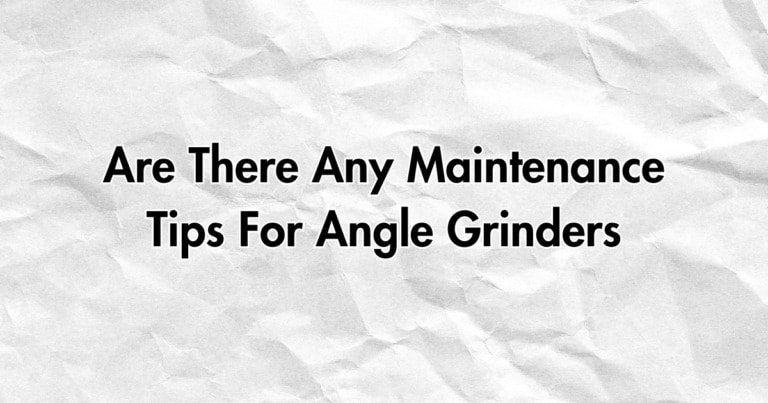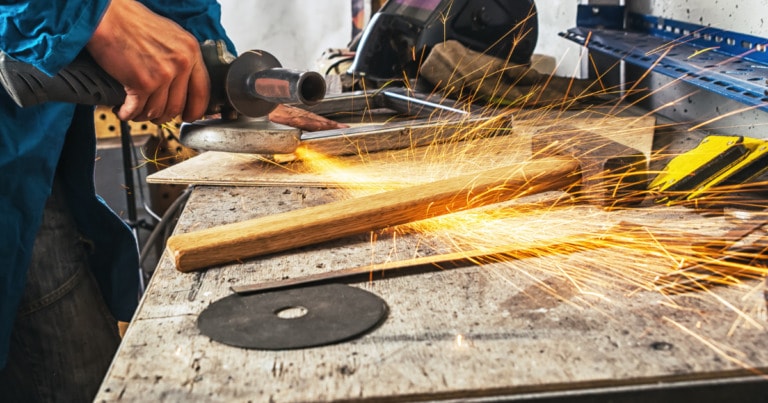
Are you wondering how to choose the right angle grinder for heavy-duty tasks? Well, you’ve come to the right place! Angle grinders are powerful tools that can handle a variety of tasks, from cutting and grinding metal to polishing surfaces. But with so many options available, it can be overwhelming to know which one to choose. Don’t worry, we’ve got you covered with some helpful tips and advice!
When it comes to selecting the right angle grinder, there are a few key factors to consider. First, you’ll want to think about the power of the grinder. Heavy-duty tasks require a grinder with a high-power motor that can handle tough materials effortlessly. Look for grinders with wattage ratings above 1000 watts for optimal performance.
Next, consider the size of the grinder. Angle grinders come in different sizes, typically ranging from 4 to 7 inches. Smaller grinders are lighter and more maneuverable, making them ideal for intricate tasks. However, a larger grinder with a larger grinding disc will provide more power and efficiency for heavy-duty jobs.
Finally, don’t forget about safety features. Look for grinders with features like adjustable guards, anti-vibration handles, and safety switches to ensure your protection while working with the tool. Safety should always be a top priority when choosing any power tool, especially one as powerful as an angle grinder.
So, whether you’re a DIY enthusiast or a professional tradesperson, selecting the right angle grinder is crucial for tackling heavy-duty tasks effectively. By considering power, size, and safety features, you’ll be well-equipped to make an informed decision. Let’s dive deeper into these factors and explore everything you need to know about choosing the perfect angle grinder for your needs!
How to Choose the Right Angle Grinder for Heavy-Duty Tasks: A Comprehensive Guide
Need help picking the perfect angle grinder for heavy-duty jobs? Follow these simple steps:
- Assess your needs and determine the tasks you’ll be performing
- Consider the power output and motor size required for your projects
- Check for adjustable speed settings for versatile use
- Look for safety features like a lock-on switch and guard
- Read reviews and compare brands for durability and reliability
Make an informed decision and tackle those tough projects with ease!
What is an Angle Grinder?
Before diving into the specifics, let’s start with the basics. An angle grinder, also known as a disc grinder or side grinder, is a handheld power tool with a rotating abrasive disc. It is primarily used for grinding, cutting, and polishing a variety of materials, including metal, stone, concrete, and tiles. Angle grinders are designed for both professional and DIY use, and they come in various sizes and power options.
One of the key features of an angle grinder is its ability to be fitted with different types of discs or wheels, enabling it to perform a wide range of tasks. These include grinding discs for shaping and smoothing surfaces, cutting discs for cutting through materials, wire brushes for rust removal, and polishing pads for finishing work. With its versatility and power, angle grinders have become an essential tool in many industries and applications.
Factors to Consider When Choosing an Angle Grinder
Choosing the right angle grinder for heavy-duty tasks requires careful consideration of various factors. Let’s delve into each of these factors to help you make an informed decision:
1. Power and Motor Size:
The power and motor size of an angle grinder determine its performance and ability to tackle heavy-duty tasks. For demanding applications, such as cutting through thick metal or concrete, opt for a higher wattage and a larger motor. Typically, angle grinders range from 500 to 2500 watts, with higher-wattage models offering more power and faster material removal.
It’s also important to consider whether you need a corded or cordless angle grinder. Corded models provide continuous power but are limited by the length of the cord, whereas cordless grinders offer portability and freedom of movement but require battery charging.
2. Disc Size:
The disc size is another crucial factor to consider. Angle grinders are available in various disc sizes, typically ranging from 4.5 inches to 9 inches. Smaller grinders are lighter, more maneuverable, and suitable for precision work, while larger grinders are more powerful and suitable for heavy-duty tasks. Choose a disc size that matches the type of work you will be doing.
3. Speed and Control:
The speed at which an angle grinder operates can significantly impact its performance and versatility. Most angle grinders offer variable speed settings, allowing you to adjust the RPM (revolutions per minute) to suit different materials and tasks. Higher RPMs are better for cutting, while lower speeds are ideal for grinding and polishing.
Additionally, look for angle grinders with features that enhance control and safety, such as adjustable handles, antivibration systems, and spindle locks for easy disc changes.
4. Safety Features:
Safety should always be a top priority when working with power tools. Look for angle grinders with safety features such as guards that protect against sparks and debris, as well as a quick-stop mechanism to prevent accidental starts.
Remember to wear the appropriate personal protective equipment (PPE), including safety glasses, gloves, and ear protection, when using an angle grinder.
5. Additional Features and Accessories:
Consider any additional features or accessories that may enhance your angle grinder’s functionality and convenience. These can include features like tool-free disc changes, dust collection systems, auxiliary handles for better control, and integrated LED lighting for improved visibility.
It’s also worth investing in high-quality abrasive discs or wheels tailored to your specific tasks. Different materials require different types of abrasives, so choose accordingly.
Now that we have covered the key factors to consider let’s explore some additional tips and recommendations for choosing the right angle grinder for heavy-duty tasks.
Additional Tips and Recommendations
1. Test Ergonomics:
Before making a purchase, it’s essential to test the ergonomics of the angle grinder. Check if the grip feels comfortable and if the weight is manageable for extended periods of use. An angle grinder that is comfortable to hold and operate can significantly reduce fatigue and improve overall control.
2. Read User Reviews:
Take the time to read user reviews and ratings of the angle grinder models you are considering. Hearing from experienced users can provide valuable insights into the performance, durability, and overall satisfaction with the tool. Additionally, look for reputable brands known for producing reliable and high-quality power tools.
3. Seek Expert Advice:
If you are unsure about which angle grinder is best suited for your needs, don’t hesitate to seek advice from experts or professionals in the field. They can provide personalized recommendations based on their experience and knowledge.
By considering these factors, tips, and recommendations, you’ll be well-equipped to choose the right angle grinder for heavy-duty tasks and take your projects to the next level. Remember to prioritize safety and always follow the manufacturer’s instructions and guidelines for optimal performance and longevity of your angle grinder.
Frequently Asked Questions
Choosing the right angle grinder for heavy-duty tasks can be challenging. Here are some commonly asked questions to help you through the process.
1. What factors should I consider when choosing an angle grinder for heavy-duty tasks?
When selecting an angle grinder for heavy-duty tasks, there are a few important factors to consider. Firstly, consider the power of the grinder. Look for a higher amp rating, as it indicates more power. Additionally, pay attention to the disc size.
For heavy-duty tasks, a larger disc size is generally preferred for better cutting and grinding performance. Finally, check the RPM (revolutions per minute) rating. Higher RPMs mean faster grinding and cutting speeds. Keep these factors in mind to choosing the right grinder for heavy-duty tasks.
However, it’s important to note that the specific requirements of your tasks should also be considered. Different projects may have unique needs, such as specific disc types and accessories. Always evaluate your specific job requirements before making a final decision.
2. Should I choose a corded or cordless angle grinder for heavy-duty tasks?
Both corded and cordless angle grinders have their advantages and it ultimately depends on your specific needs. Corded angle grinders provide a continuous power source, making them suitable for demanding heavy-duty tasks that require prolonged use. They also tend to have more power and higher RPM ratings. On the other hand, cordless angle grinders offer greater mobility and flexibility, which can be advantageous in certain situations.
If you anticipate working on heavy-duty tasks for extended periods without access to electricity, a cordless angle grinder with a reliable battery life may be a better choice. However, if continuous power and higher performance are your primary concerns, a corded angle grinder would be the preferred option.
3. What safety features should I look for in an angle grinder for heavy-duty tasks?
Safety should always be a top priority when selecting an angle grinder for heavy-duty tasks. Look for grinders equipped with features such as a safety guard, which protects against sparks and debris during operation.
A quick and easy-to-use disc-changing mechanism is also important to minimize the risk of accidents. Additionally, consider angle grinders with anti-vibration handles for better control and reduced user fatigue. Finally, always wear the appropriate personal protective equipment (PPE) including safety goggles, gloves, and a face shield when operating an angle grinder.
Ensure that the angle grinder you choose adheres to safety standards, such as those set by regulatory organizations like OSHA (Occupational Safety and Health Administration) or ANSI (American National Standards Institute). This ensures that the grinder has undergone safety testing and meets the necessary requirements.
4. Can I use a regular grinding wheel for heavy-duty tasks?
When it comes to heavy-duty tasks, it’s important to use a grinding wheel that is specifically designed for such applications. Regular grinding wheels may not be able to withstand the high forces and pressures encountered during heavy-duty tasks, leading to potential breakage or accidents. Look for grinding wheels that are labeled as “heavy-duty” or “for metal” to ensure they are suitable for your tasks.
Additionally, pay attention to the wheel’s rating and make sure it is compatible with your angle grinder. Using a grinding wheel that is too large or too small for your grinder can lead to instability and pose safety risks. Always refer to the manufacturer’s guidelines and instructions for the recommended wheel sizes and types for heavy-duty tasks.
5. How do I maintain and prolong the lifespan of my angle grinder for heavy-duty tasks?
To ensure the longevity of your angle grinder for heavy-duty tasks, proper maintenance is crucial. Regularly inspect and clean the grinder, removing any debris or dust build-up that may affect its performance. Check the power cord for any damages or fraying, and replace it if necessary.
Additionally, lubricate the moving parts of the grinder as recommended by the manufacturer. This helps to reduce friction and maintain smooth operation. Store the angle grinder in a clean, dry place, and protect it from extreme temperatures or humidity. Finally, follow the manufacturer’s guidelines for routine maintenance tasks such as replacing worn-out carbon brushes or checking the disc for any signs of wear or damage.
Choosing the right angle grinder for heavy-duty tasks is essential for getting the job done safely and effectively. The key points to consider are the power source, disc size, and safety features. When it comes to power sources, corded grinders provide consistent power, while cordless grinders offer more mobility.
Disc size should match the intended application, with larger discs for bigger jobs. Safety features like a toolless guard adjustment and spindle lock are important for protecting yourself while using the grinder. It’s also crucial to wear appropriate safety gear and follow proper handling and maintenance guidelines.
By considering these factors, you can make a smart choice and accomplish your heavy-duty tasks with ease.



